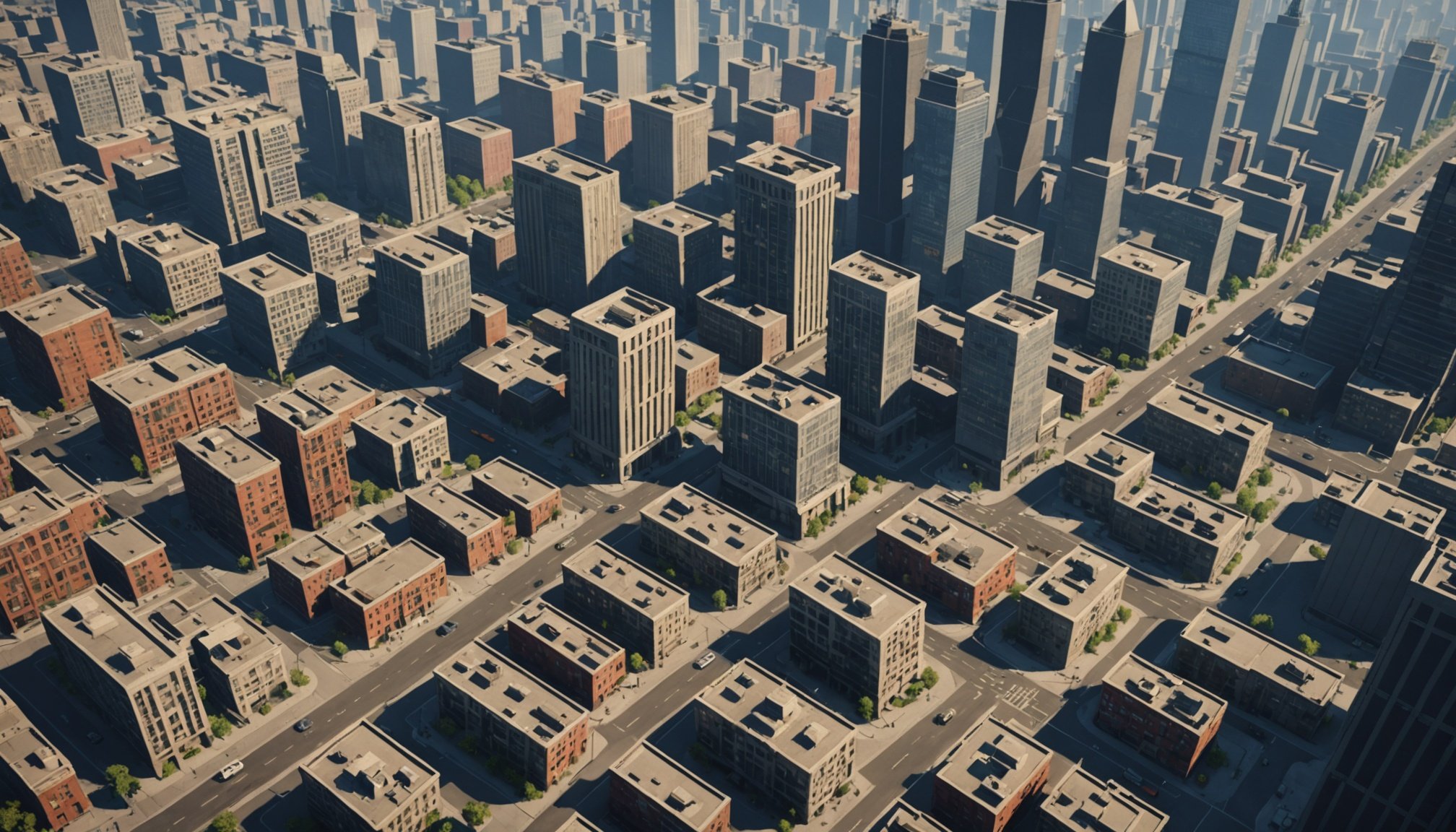Understanding Procedural Generation in City-Building Games
Procedural generation is a method in game design where content is algorithmically created instead of manually. In city-building games, this method allows for the creation of unique and intricate landscapes. As games have evolved, procedural generation has become a cornerstone of game design principles, offering near-infinite variability and replayability.
Historical Context
The concept has roots in early gaming, with titles like “Rogue” experiencing the benefits of procedurally generated dungeons. Over decades, this approach has advanced, enabling developers to simulate complex ecosystems and city environments. The evolution reflects a shift from simplistic models to sophisticated simulations, demanding higher computational power and creative algorithms.
Also read : Unleashing procedural innovation: using machine learning to design distinct levels in roguelike games
Advantages in City-Building Games
- Infinite Variety: Players enjoy diverse urban landscapes without repetitive patterns.
- Resource Efficiency: Procedural generation reduces the need for exhaustive manual content creation.
- Enhanced Replayability: The unpredictable nature ensures each gaming session offers a fresh experience.
Applying procedural generation in city-building games not only enriches player engagement but also embodies core game design principles. This technique allows for dynamic worlds, aligning with players’ desire for exploration and creativity, pushing the boundaries of what’s possible in virtual cityscapes.
Techniques for Implementing Procedural Generation
Using procedural techniques can significantly streamline game design, especially in creating dynamic city landscapes. These methods often rely on advanced algorithms to produce individualized environments.
Also read : Empowering developers: innovative blockchain solutions to prevent cheating in online multiplayer games
Noise Functions
Noise functions are essential for creating detailed landscapes. By generating pseudo-random values, they produce textures and terrains which mimic natural irregularities. This makes them a favourite in algorithms for creating realistic-looking environments without heavy computational loads. Ideal for terrains, these functions add complexity while keeping memory usage low.
L-Systems
L-Systems, rooted in mathematical logic, are used primarily for simulating organic growth patterns, like trees and plants within a cityscape. They rely on a recursive algorithm, creating branching patterns that are both aesthetically pleasing and computationally efficient. Such systems are particularly useful in procedural city design where nature intermixes with urban elements.
Cellular Automata
Cellular Automata demonstrates city evolution by simulating cells on a grid, each with rules dictating their state based on neighbouring cells, ideal for urban expansion and road networks. These models allow for the simulation of life-like scenarios, aiding in the organic growth of city design. Each technique provides distinct capabilities for city design, with varying strengths tailored to specific design needs.
Case Studies of Successful City-Building Games
City-building games have captivated players through their intricate design and strategic gameplay. Successful examples often utilize procedural generation, which ensures each player experiences a unique city layout. Games like SimCity and Cities: Skylines excel in this, offering rich environments that evolve based on player decisions.
The integration of procedural generation enhances gameplay by providing endless replayability and diverse challenges. Players must adapt strategies to navigate varying landscapes and resource distributions, making each session distinct. This keeps the user experience engaging, drawing players back to the game repeatedly.
Insights from Developers
Game developers acknowledge both the challenges and successes in implementing procedural generation. One major challenge lies in balancing unpredictability with a coherent gameplay structure. Procedural elements must intertwine seamlessly with game mechanics to avoid confusion. Successful developers cite iterative testing and player feedback as crucial components in refining their processes.
Moreover, developers highlight the innovation procedural generation brings, allowing for creative storytelling and world-building within the game. By overcoming initial challenges, developers unlock a multitude of possibilities, delivering immersive experiences that resonate with players. Unveiling these insights offers a deeper understanding of how procedural generation transforms city-building games into dynamic and lasting successes.
Future Directions and Innovations in Procedural Generation
In today’s fast-evolving gaming landscape, future trends and innovations in procedural generation promise to redefine the boundaries of next-gen gaming. Here, we delve into exciting possibilities that await us.
Advancements in AI and Machine Learning
Recent progress in AI and machine learning is fostering unprecedented developments in procedural generation. By enhancing the algorithms that underpin these processes, AI not only increases the complexity and uniqueness of generated content but also refines the quality of game worlds. This promises seamless integration of rich, dynamic environments into next-gen games, where every player’s experience feels uniquely tailored. The potential for AI-driven procedural mechanics could transform game development, making worlds more realistic and interaction-rich.
Community-Driven Content Creation
The role of community feedback and creation is gaining momentum in procedural generation. Platforms offering creation tools enable players to influence game design, leading to a more participatory development process. This collaborative approach empowers players to innovate, thereby expanding game content beyond traditional boundaries. With players as co-creators, games become evolving entities, reflective of their community’s collective creative vision.
Potential for Dynamic Storytelling
Procedural generation is increasingly focused on enhancing narrative depth through dynamic storytelling. Future city-building games could incorporate adaptive storylines that respond to player choices and environments, enabling a personalized, engaging experience. Cutting-edge technologies could fuel these advancements, creating stories that evolve alongside the gameplay, providing a fresh narrative each playthrough.
Expert Insights on Procedural Generation
Procedural generation is a powerful tool in game development, offering creators a chance to craft dynamic worlds with less manual effort. Expert opinions emphasize that success hinges on understanding both technical and creative elements. Interviews with industry experts reveal that the key lies in development strategies that blend artistry with algorithmic design.
To effectively integrate procedural generation, prioritize a robust conceptual framework. Combine this with industry insights about player experience to ensure your game’s landscapes are both unpredictable and engaging. Experts warn against over-reliance on algorithms; games should retain some crafted elements to avoid monotonous outcomes.
When implementing procedural generation, consider these strategies:
- Hybrid Approaches: Balance procedural content with curated elements to maintain quality and variety.
- Iterative Testing: Regularly test your algorithm outputs to align them with creative vision and player expectations.
- Adaptive Design: Allow your algorithms to adjust according to player choices, enriching gameplay dynamics.
Common pitfalls include neglecting the player’s perspective or failing to iterate designs. By learning from these mistakes and leveraging expert insights, developers can harness procedural generation’s potential fully. The synergy of well-informed strategies and creativity leads to innovative, captivating games.
Visual and Technical Comparisons
Understanding the differences in procedurally generated environments can be complex. With the help of visual aids and detailed comparison charts, these differences become clearer.
Graphical Representations of Procedural Generation Outcomes
Procedural generation offers a diverse range of outcomes. Visual aids like diagrams and charts can effectively illustrate these variations. For instance, consider a procedural game that generates unique landscapes. A comparison chart showing different map layouts visually demonstrates the variety generated in each playthrough, helping players appreciate the algorithm’s capacity to produce distinct environments.
Performance Metrics: Traditional vs. Procedurally Generated Environments
Evaluating performance metrics is essential to understand the effectiveness of procedural generation. Data often shows that procedurally generated environments can vary in terms of resource consumption and load times. A technical breakdown using comparison charts reveals how these metrics stand against traditional methods, providing insight into optimisations or necessary improvements for smoother gameplay experiences.
Player Engagement Data
Player engagement levels significantly differ between procedurally generated and fixed environments. Studies indicate that players often experience increased replayability and novelty in procedurally generated settings. By utilising technical breakdowns, developers can highlight how player interaction data fosters refined content design, thus ensuring ongoing engagement and player satisfaction.











